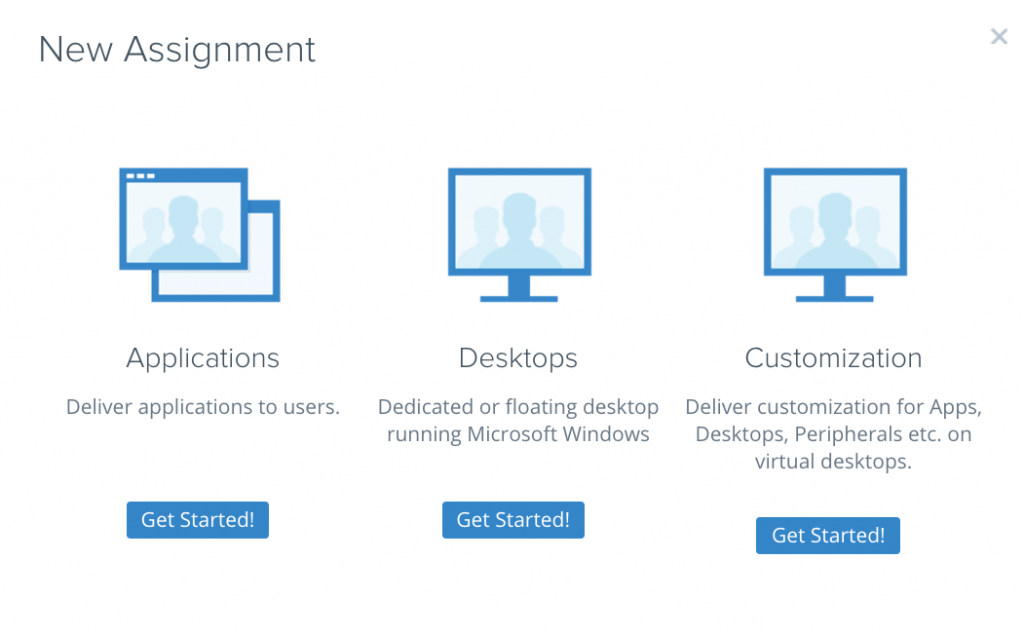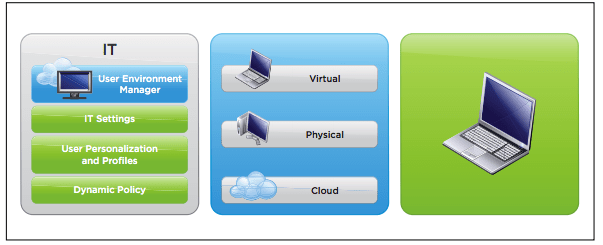More details about Horizon Air Hybrid-Mode
Last week VMware announced Horizon Air Hybrid-Mode, formerly known as Project Enzo. This article shares some more details.
Known as Project Enzo prior to launch, Horizon Air Hybrid-Mode consists of a cloud service, Horizon Cloud Services, which pairs with an on-premises component, Horizon Air Node. Horizon Air Hybrid-Mode allows you to leverage the best of both worlds: the economics and the simplicity of the cloud with the security and performance of on-premises infrastructure.
- Horizon Cloud Services – A control plane hosted in the cloud by VMware for central orchestration and management of virtual desktops, applications, and user profiles on on-premises infrastructure.
- Horizon Air Node – Optimized hardware including Virtual SAN-ready nodes and supported hyper-converged infrastructure that run on the organization’s premises or on VMware-partner-managed IaaS, connected to the cloud control plane by way of integrated Horizon Air Hybrid-Mode software.
The Horizon Air Hybrid-Mode service provides you with access to the Horizon Cloud Manager, plus the software necessary to
- Pair the on-premises hardware with the cloud control plane
- Deliver virtual desktops and manage applications that are served from the desktop or are user-installed
Much like the cell phone model, organizations can select validated hardware (a cell phone) available from our partner ecosystem and pair it with the Horizon Air Hybrid-Mode service from VMware (the cell phone plan) to start delivering virtual desktops and applications (phone calls).
Key Elements of Horizon Air Hybrid-Mode
Here is a closer look at the main features and technologies that make up Horizon Air Hybrid-Mode and that translate into cost savings and simplified day-to-day management for your organization.
Horizon Cloud Services with Horizon Cloud Manager
Horizon Cloud Services is a control plane hosted by VMware in the cloud; it enables the central orchestration and management of virtual desktops, applications, and user profiles on on-premises infrastructure. Horizon Cloud Services is a set of microservices which enables end-to-end management workflows such as inventory management, App Volumes AppStack management, and so on.
VMware is responsible for hosting the service and providing feature updates and enhancements for a true software-as-a-service experience. You can select a convenient time to accept any updates that need to be pushed into the on-premises sites. You can choose whether to have all data and applications stay on premises so that only metadata is stored in the cloud.
The cloud control plane also hosts a common management UI called Horizon Cloud Manager. The Horizon Cloud Manager is accessible by way of all major browsers and provides IT administrators a single location for managing desktop images, applications, user data, profiles, and assignments. The Horizon Cloud Manager is accessible from anywhere at any time, providing maximum flexibility.

The cloud control plane was built from the ground up to be a highly scalable, multi-tenant management service, leveraging the architecture of our VMware Horizon Air platform, which had multi-tenancy “baked” in right from the start.
Note that VMware is building a single cloud-control plane that can be paired with any deployment of your choosing, whether the virtual desktops and applications reside on infrastructure on premises, or on VMware-partner-hosted and -managed IaaS, or on VMware Horizon Air. (See Figure 3.) This unified architecture will be the key to providing powerful upcoming features such as true hybridity across the cloud and on premises.

Horizon Air Node
Acquiring the necessary hardware required to build and scale a high-performance virtual desktop environment can be challenging and in many cases expensive. Additionally, determining all the specific software needed can complicate the plan.
To simplify the process and provide a solution as turnkey as possible, VMware developed an architecture that sits on top of a number of different converged and hyper-converged infrastructures with
- Integration into the infrastructure stack for easy onboarding, management, and expansion
- A common set of management interfaces to connect to the Horizon Cloud Services control plane.
These units of infrastructure capacity are called Horizon Air Nodes. They come in convenient sizes and are purposely built for virtual desktops and applications, thus driving down the initial capital expense typically associated with traditional VDI solutions. Figure 4 shows the hardware and software elements of a Horizon Air Node. The upper box depicts the Horizon Air Node software, which is a Linux-based technology stack of virtual machines. The software sits on top of qualified hardware, as depicted by the lower box.

Horizon Air Node pairs with Horizon Cloud Services at installation time by way of a field-installable bootstrap appliance called Horizon Air Link, which orchestrates the initial setup and pairing with the cloud control plane for ongoing management and communication. Cloud Connector provides connectivity to the cloud without requiring a dedicated site-to-site VPN.
Horizon Air Node can reside on premises or be VMware-partner-managed IaaS that is joined to Horizon Cloud Services, offering you freedom of choice.
Because Horizon Air Node can be on premises, close to your data and applications, it removes latency issues and provides a superior user experience.
Just-in-Time Desktops
Horizon Air Hybrid-Mode includes a new VMware capability: Just-in-Time Desktops. Just-in-Time Desktops are desktops that can be rapidly assembled on demand using VMware Instant Clone Technology, App Volumes, and VMware User Environment Manager.
Instant Clone Technology allows identical virtual machine clones to be created at the amazing speed of one clone per second, on average. This feature builds a new virtual machine by cloning an existing, partially booted parent virtual machine, thus significantly reducing the disk and memory requirements and I/O cost of provisioning. The instant clone process is 30 times faster than our previous desktop cloning technology!

This new feature became even more exciting when we coupled Instant Clone Technology with the notion that every desktop is disposable after use and can be assembled on demand by layering properties such as base image and desktop specification (memory, compute, and so on) at build time. In addition, applications, user data, and user-installed applications can also be attached to the operating system as users log in, thus providing a full persistent experience using nonpersistent desktops. See the following sections, App Volumes – Application Delivery and Management and User Environment Manager for more details.
The benefits of these new features are tremendous! Desktops are delivered almost instantly. Not only that, but because all desktops are rebuilt with the latest image, and the end user always gets the latest image on login, the recompose window for image updates is eliminated, and no more costly reboots are required.
The number of image configurations that the IT administrator must create and manage is also dramatically reduced because, instead of having a unique image combination for every different need, elements can now be dynamically combined.
One of the biggest complaints we often hear from IT administrators is about keeping the base images and additional software up to date for Windows Updates and the constant change that occurs with software upgrades for the many applications deployed in organizations’ environments. With Instant Clone Technology, an administrator can refresh thousands of desktops in tens of minutes across multiple servers. This is handy, particularly on Patch Tuesday. Every month, administrators are faced with needing to update the OS patches on all of their endpoint devices, whether physical or virtual. Instant Clone Technology enables this to happen within minutes rather than hours, and does so without any downtime as well.
App Volumes – Application Delivery and Management
App Volumes is the VMware real-time, on-demand, user-targeted application delivery technology that allows you to deliver a persistent-like desktop experience with nonpersistent economics. Applications are stored in read-only virtual disks that, with the click of a button, instantly attach to individual or groups of virtual desktops or users. Imagine being able to deploy Microsoft Office to hundreds of virtual desktops by deploying the software only one time. Imagine the CPU and storage I/O savings! That is the value of App Volumes.
App Volumes is completely embedded into Horizon Air Hybrid-Mode, enabling you to leverage all the benefits of App Volumes for true user workspace management. You can configure your applications and assign them to users by way of the Horizon Cloud Manager, alongside desktop and user environment management, simplifying workspace management as a whole.

User Environment Manager
VMware User Environment Manager is the VMware user environment management solution that provides a way for IT to deliver the personalization settings that users expect, without the need to invest in costly infrastructure, training, and complex management. As with App Volumes, VMware is working to fully embed User Environment Manager into Horizon Air Hybrid-Mode, so that you can leverage User Environment Manager functionality with ease. You will be able to try out managing and assigning frequently used user settings such as printer mappings, shortcuts, environment variables, and so on, by way of the Horizon Cloud Manager, alongside desktop and application management.

Source and more: http://blogs.vmware.com/euc/2016/02/introducing-horizon-air-hybrid-mode.html
Leave a comment